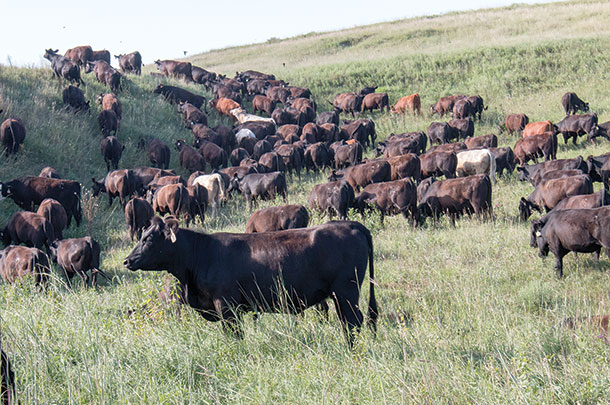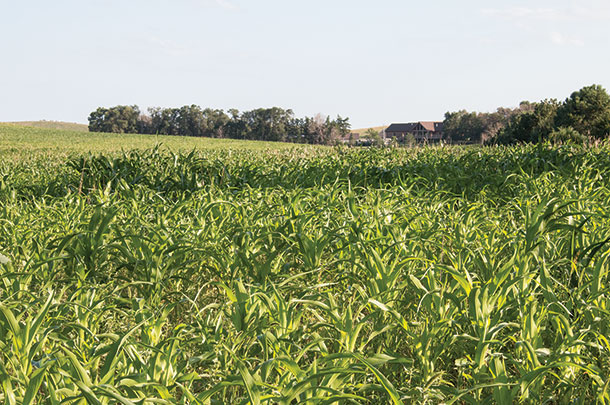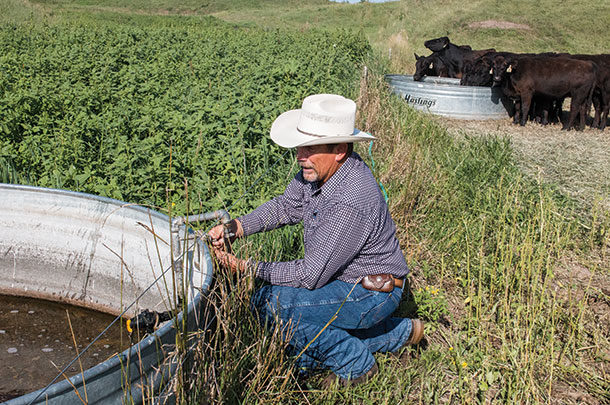Steve Grudzinski says, “I didn’t have enough feed to get them through the winter, so I sold them. And I was planning to rent the ground out because it was too expensive to re-stock. There was no way I could afford to pay $3,000 for a cow because there was no way I’d get that back, so it spooked me.
But I had the grass, and grass is always in short supply, always wanted. It’s really easy to find tenants, and there were a lot of guys interested in renting the grass.”
Grudzinski leased his ground for a few years, first to a cow-calf outfit, where Grudzinski agreed to care for the cattle. “But I was new to the game,” he says. “The cows that were sent here weighed about 1,600 pounds, and they had January calves weighing 300 pounds.” With heavier animals, he had to cut his stocking rate.
His next strategy was a custom-grazing contract through a local feedlot, where yearling heifers arrived on May 1 and were grazed until Sept. 1. The feedlot retains ownership, and the heifers come in around 600 pounds, already vaccinated and ready to graze.
Grudzinski says it takes about two weeks to settle the heifers and train them to move through his rotation system, where they’re moved in bunches of about 250 head every two or three days. After that, essentially no “gathering” is required as the cattle follow him across the pasture and through the next gate, knowing fresh feed is waiting.
Grudzinski and the cattle owners are both responsible for herd health during the summer grazing. The cattle owner pays for the vaccine, and Grudzinski provides the labor. He carries a dart gun with him as he moves cows to treat pinkeye and foot rot and says, “It’s quick, easy, and the cows don’t have to even know they’ve been treated.”

Grudzinski is paid per head by the day, not by pound of gain. The current system – contracting May 1 to Sept. 1 – means no breaking ice, no calving and less stress. It also means Grudzinski has winters off – except that he likes to do day work on a feedlot in winter, sell Stull Feeders and cattle panels on the side, and play with his registered “hobby” herd of British Whites.
One of the early adjustments Grudzinski made was to fill the late-summer forage slump the last few weeks before the cattle went to the feedlot. The late Terry Gompert, a University of Nebraska Extension specialist, convinced him to raise grazing corn on 35 acres of old farmground. Grudzinski says, “The first year, it brought in twice as much money by grazing it than by taking it off for grain corn.
Going by memory – I think we got 720 pounds of animal per acre on the corn field – and we’re talking about half-drought, 70-bushel corn.”
In order to figure out pasture size and stocking rate on corn, Grudzinski says, “Let’s say there were 40 bushels an acre to the corn; you figure out how many pounds was in that. I wanted to give my cows 5 pounds of corn, so I walked off strips that would give me that – whether it was 100 feet wide and however long.
If I needed one-fifth of an acre, I’d figure out the square feet that would be and fence that part and turn the cows into that part, which gave them 5 pounds. And they were surprisingly content. I never did it with high-yielding corn; I did it with low-yielding corn. With 200-bushel-an-acre corn, it would be hard to do that.”
After that, Grudzinski was convinced and transitioned to grazing corn. But he made mistakes along the way. As he walked through his 2016 field of grazing corn, he said, “I initially planted this to cereal rye and didn’t burn it down before planting grazing corn.
The rye puts out a poison, so it killed off the first corn planting. I still should have burned it down before the second corn planting, but I didn’t. So this year’s crop, I consider a disaster.”
In 2017, Grudzinski plans to interseed sunflower into the grazing corn but says he doesn’t like to mess with the mix much. He says, “I don’t need several hits; I just want to hit one home run in those two weeks [of late summer]; that’s the goal.” When the heifers graze these fields, he provides sodium bicarbonate in loose tub form.
In order to increase capacity on his 1,100 dryland acres, Grudzinski has worked with University of Nebraska forage specialist Bruce Anderson. Grudzinski says at the beginning of the ranch’s custom-grazing era, the cows ate only the grasses they wanted, “the ice cream grass,” and wouldn’t touch the Kentucky bluegrass or brome.
“They were always chasing the big bluestem, and you couldn’t even find any big blue on the place,” he says. As a result, the bluegrass would get about a foot tall and then lay over, creating a mat that smothered the younger grasses. Grudzinski says, “And that’s when I got associated with Bruce. I said, ‘Bruce, there is no warm-season grass in this pasture. I think we should kill it off and start over.’”
But Anderson convinced him, “It’s there, it’s there.” Anderson encouraged him to put up cross-fences to graze it more intensely.
So Grudzinski started building fence. He says, “Then I noticed they’d go to a side hill and just smoke it, and the next time around they wouldn’t graze anything but the side hill.” So he called Anderson again, whose response was, “Build more fences,” so he built more fences.

When Grudzinski still didn’t see much improvement in grazing patterns, he called Anderson again, who told him, “You don’t have enough cattle in there.” He explained that the cattle weren’t grazing evenly because there wasn’t enough competition. Grudzinski says, “So I put more cattle in and, lo and behold, after about four or five years big bluestem is coming up everywhere – the ice cream grass.” He has now interseeded the native range with alfalfa and cicer milkvetch.
On Anderson’s recommendation, Grudzinski continued adding more cross-fences until now he has a system that works; it includes pastures 10 to 20 acres in size, with bunches of 200 to 300 heifers grazing three days maximum in any pasture, which leads to a 45- to 60-day rest period.
Grudzinski’s strip grazing method doesn’t have a set rotation schedule because, as he says, “You have to read the bunk. It all depends on weather and rainfall.”
Grudzinski has been on the Loup City Ranch since 1986, and having made the transition from cow-calf herd to custom grazing, he says, “I love [custom grazing] yearlings because they’re liquid; if you run into trouble, you can sell them.” When he custom-grazed the cows, the calves were weaned but the cows had to stay grazing until October, requiring him to reserve feed.
During years like 2016, when he had plenty of feed, he took on some bred heifers to finish grazing after the feedlot heifers were shipped.
While Grudzinski didn’t initially view the drought of 2012 as a blessing, he’s nevertheless been able to capitalize on the situation, to keep doing what he loves and stay profitable. ![]()
PHOTO 1: Steve Grudzinski prepares the water source for moving custom-grazed heifers to the next pasture.
PHOTO 2: A series of improved fences and water developments has increased big bluestem grasses on pastures grazed by yearling heifers.
PHOTO 3: Pastures in the last two weeks of the contract-grazing season are usually hit with summer slump and poor grass quality. Grudzinski planted grazing corn on 35 acres of old farm ground to maintain cattle gains and conditioning during the slump. Photos by Lynn Jaynes.

-
Lynn Jaynes
- Editor
- Progressive Forage
- Email Lynn Jaynes












